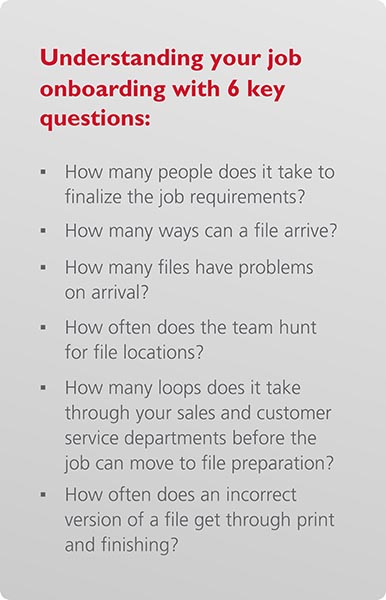Adopting vendor neutral workflows: No-hassle job management and cloud
Cloud-based services can be a huge benefit for small and medium-sized printers. Pat McGrew, a Ricoh sponsored writer, explains that offering rules-based, automated workflow technology in a SaaS-environment, with simple, easy to use tools, eliminates the need for IT expertise and a heavy infrastructure. The key to overall workflow profit starts with job onboarding.

Automation Cloud
Cloud-based workflow solutions provide ultimate flexibility. Software as a Service – SaaS – solutions allow you to expand andcontract as you move through seasonal changes in volumes without investing inexpensive server upgrades, storage expansion, or other on-premise upgrades. As you grow, the capacity will always be there. This scalability is integrated with anywhere and anytime access to criticalbusiness processes, including Customer Relationship Management(CRM), Inventory Management, and Management Information Systems(MIS).
Now, add task automation to your print shop, and you will have a modern, state-of-the art facility that can reduce labor and touchpoints while saving money.
Your production environment will have superpowers with end-to-end automation that streamlines repetitive processes, shares information between systems, and displays current statuses. You can do more work with less touchpoints, resulting in a better use for staff time and an optimized machine capacity. Start by walking through your workflow to gain a competitive edge. Investigate what you do today and how your inefficiencies could be affecting your bottom-line.

The research shows that while integrated automation can be beneficial to virtually any workflow task, in-plant printing and print-forpay are the most common print environments. Job onboarding Software tools that connect the critical processes together and streamline your path to profitability are the best way to gain efficiency.
Automate to Accelerate
Job onboarding This is where most print businesses lose time and negatively affect their profitability. Printers who still accept inefficient methods of job submission such as email are losing a lot of time in downloading and testing job files. A virus-infected file may also land on a production system, causing damage to your systems. Removing the infected files can be a lengthy and difficult process, further delaying job turnaround.
The most common complaints are caused by the lack of process automation. These include chasing down files, repairing specs, solving file problems and waiting for information.
To get an idea of how cloud-based automated could change your profitability profile, Onboarding is the first step.
The workflow for in-plants and print for pay operations is slightly different, but the process is the same. It is not necessary to be a member of the? The customer specifies their job specifications and you then move them into your order entry system.

Some printers receive the same problems every time they receive a job. It can take several hours or even days to resolve these issues. This impacts production schedules, and increases costs that decrease profits. Others find that their largest customers are the most slow to respond, which can cause production delays and have a negative impact on productivity. When disparate and unconnected processes and systems are in use, such as emails, phone calls, or chats, then there is no one source of visibility. This can lead to duplication, miscommunication, and loss of profits with each additional touch point.
Automating the job onboarding process ensures consistency in how jobs are received and documented, whether you have one site or several. Your workflow can include consistent notifications to reject problem jobs, and return them back to the client along with information on any problems found. This can be done without the staff having to lift a single finger. It increases productivity because the process automation knows the rules, applies the rules consistently, and only alerts the team if there is a problem the system doesn’t recognize.
Automating the job onboarding process will improve your workflow, and affect your overall management of jobs throughout the lifecycle of each job. To maximize your resources and profits, schedule an audit in order to understand your workflow.
The benefits of job onboarding and automation of processes are felt throughout the entire business. The files will not be moved into the process unless they’re ready for the next step in production. The accuracy of rules based automation ensures less delays, superior printing quality, optimized turnaround times, and reduces waste due to print rework.
Automated onboarding of new employees also increases security. Each file can be scanned, irrespective of the customer. It saves time and prevents intrusive malware from entering production environments, where even Digital Front Ends can be infected.
Cloud-based Automation to Improve Customer Satisfaction
Client portals can have a dramatic effect on productivity and efficiency. There are fewer mistakes, delays, and calls.
Client portals let you and your customer manage the work that’s submitted to print. They can be programmed so that they only accept the agreed-upon job specifications, create proofs, and allow customers to track the status of the work without having to ask their customer service representative. If there is an issue with the job proof, best systems offer tools to correct it, keeping the work on its way to production. The idea of an automated future, which leverages current technology, and establishes infrastructure for the next-generation of automation options, can seem daunting. However, cloud-based SaaS can be implemented more quickly than on-premise software, integrated easily, and updated automatically without causing downtime. There is help out there.
The team at Ricoh has introduced RICOH TotalFlow™Producer, a comprehensive cloud platform designed to automate print production workflows beginning with job onboarding and detecting malware. It also uses data from the production floor.
Ensure that each job is produced efficiently and with maximum profit by exposing printer availability, ink levels and paper stock levels.
Speak to your Ricoh team today to find out how this cloud-based solution with a small footprint can power your print output both now and in the future, without a large investment.
Ask for a free demo today to see how automation can boost your productivity.
About RICOH TTotalFlow Prod.
RICOH TotalFlow Producer offers simple, easy to use tools that can be used for end-toend workflow production without expensive IT expertise. This SaaS-based solution, irrespective of vendor or product, automates the submission and consolidating of jobs from various sources and feeds them to any hotfolder or printer. Further, it has the ability to automate jobs before they are sent out for pre-flight and also includes PDF editing.
Key benefits:
- No vendor integration required for seamless production
- Jumpstart job onboarding, and output automation capabilities
- Automated job submissions from multiple sources
- Easy-to-set-up and cost-effective portal for customers
RICOH TotalFlow Producer uses a cloud-based approach to provide your organization with scalable, flexible and print-on demand production workflow tools without a large IT investment.
- Automate the order entry and file creation process for jobs that come from multiple online sources
- Transparency in the workflow allows for quick production decisions.
- Reassignment to more profitable tasks is possible.
- Its vendor-agnostic design seamlessly integrates with existing software and hardware
- Cloud-based environments improve security and reliability, preventing disruptions and increasing productivity.
For more information and a free, no-obligation trial of RICOH TotalFlow Producer, visit www.ricohsoftware.com.